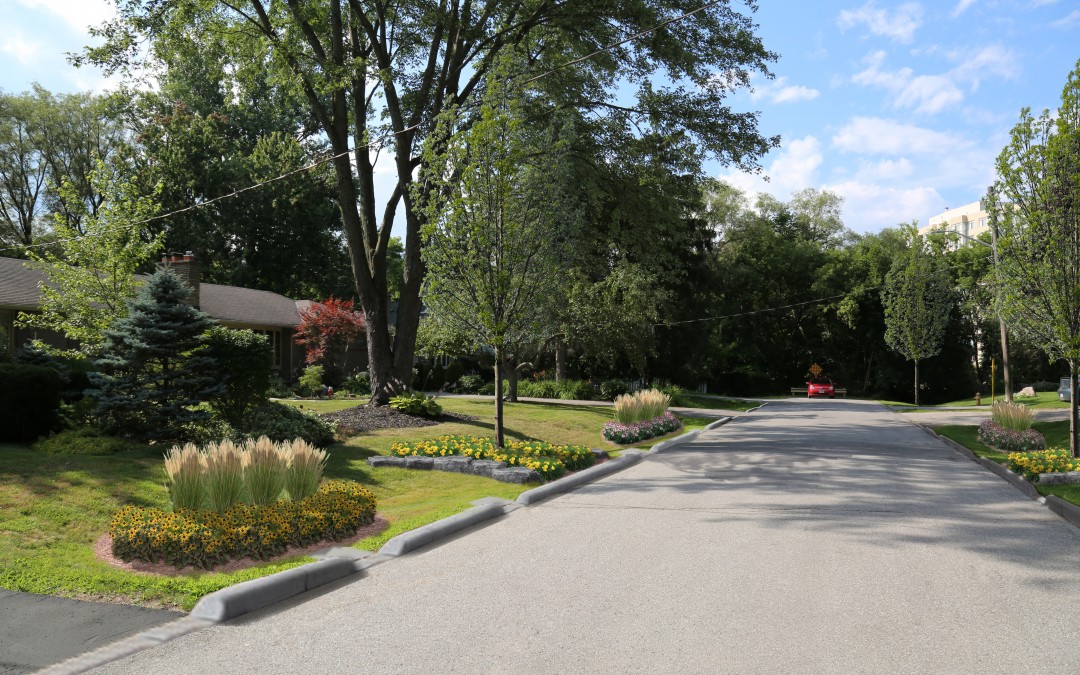Photo: LID on Forest Glen Road
Like many lakes impacted by urbanization, Ontario’s Lake Simcoe ecosystem faces challenges. This has long been recognized, and governments have been taking steps to protect and restore this ecosystem with multiple solutions, including green infrastructure.
To learn more about how the Lake Simcoe Region Conservation Authority (LSRCA) is supporting better site design practices and green infrastructure join us for our webinar Wednesday 30 March. Register online at https://raincommunitysolutions.ca/en/webinar-series/.
Over the past several years, LSRCA has become a champion for the use of green infrastructure to manage stormwater runoff. The need to reduce phosphorus levels in the Lake is one of the main drivers. Lessons learned in this area may be useful for the Lake Erie watershed, which is also looking at meeting strict phosphorus reduction targets in the coming years (both Lake Simcoe and Lake Erie have set targets to reduce phosphorus loads by 40%). Phosphorus loadings from urban stormwater runoff are difficult to measure, but watershed streams account for 56% of loads to Lake Simcoe, and urban sources are certainly a large contributor.
LSRCA programs address stormwater runoff from both new developments and existing built up areas.
For new developments, LSRCA has developed a model bylaw and stormwater management guidelines for adoption by municipalities. These are based on Minimal Impact Design Standards out of Minnesota, a long time leader in managing rain where it falls. These guidelines include the requirement to manage at least the first 25mm (1 inch) of rainfall on site in new construction, via infiltration or evapotranspiration (the standard in many U.S. municipalities).
Lake Simcoe Conservation also works closely with developers and consultants to help them implement low impact development (LID) stormwater management, which is still a growing practice for meeting quantity and quality stormwater targets. Through the RainScaping program, developers have the opportunity to meet with CA approvals and design staff at the beginning of the planning process. Through a design charrette, developers are shown the opportunities for managing stormwater on site through better site design (LID) . Though it is not yet mandatory to infiltrate runoff, some developers have opted to install green infrastructure measures because of other factors – the most compelling being the reduced need for stormwater ponds resulting in an increase in developable land. Having the CA involved in the design process also reduces the time needed for approvals.
Developers have found some unexpected benefits from installing green infrastructure – for example that houses with rain gardens on their front lawns sold more quickly than those without.
Retrofitting the existing urban landscape is a major undertaking in a highly developed watershed like Lake Simcoe. Currently, the CA is developing a retrofitting incentive program for construction of green infrastructure on industrial, institutional, and commercial lands and continuing a pilot granting program for the construction of residential rain gardens. Training and capacity building for landscaping staff is also an important part of the strategy, as they take advantage of this new business opportunity and help to promote the program.
Managing rain where it falls will soon become the norm across Ontario, and other conservation authorities and municipalities may be able to learn from the experiences in the Lake Simcoe region.
This article was published in The Umbrella Stormwater Bulletin Issue 42.
Poll
What are the barriers in working with developers to implement green infrastructure or LID?
- Lack of awareness (13%, 9 Votes)
- Lack of communication/coordination (9%, 6 Votes)
- Concern about maintenance (16%, 11 Votes)
- Concern about costs (25%, 17 Votes)
- Lack of champion (7%, 5 Votes)
- Concern about local regulations and standards (9%, 6 Votes)
- Lack of standardized approval and review process (18%, 12 Votes)
- Others (3%, 2 Votes)
Total Voters: 24

